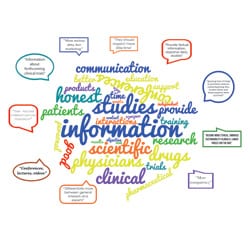 The digital communication age has dawned, and whatever profession we’re in, we’re dependent upon technology. Data published by Ofcom in 2016 illustrates how the UK population spends more time using communications than it does sleeping – across all ages. We spend over eight hours per day on social media, emailing, texting, tweeting, watching TV or listening to the radio. When it comes to doctors, the picture is very similar; it’s rare to find a doctor who doesn’t have a smartphone in use throughout the day for both social and professional purposes.
The digital communication age has dawned, and whatever profession we’re in, we’re dependent upon technology. Data published by Ofcom in 2016 illustrates how the UK population spends more time using communications than it does sleeping – across all ages. We spend over eight hours per day on social media, emailing, texting, tweeting, watching TV or listening to the radio. When it comes to doctors, the picture is very similar; it’s rare to find a doctor who doesn’t have a smartphone in use throughout the day for both social and professional purposes.
Doctors recognise that the internet has already had a huge impact on healthcare. 95% say that it’s already had a significant impact on medical practice and for the most part it’s been a positive effect.
The impact of digital technology so far has mainly been around access to information – both for HCPs and for us as patients. Before we consult a doctor, 75% of us will have looked up information about our symptoms. This means that doctors need to change the way they interact with patients and over two-thirds say that they already have – doctors say that they are becoming less paternalistic and are discussing information with patients and helping them make choices for themselves. Technology is about to bring more disruption and many more benefits to healthcare – many companies are making significant investments to develop artificial intelligence, remote monitoring and smart devices and to bring them to healthcare.
However, the situation is very different when it comes to the life science industry. Across Health’s 2016 survey of 275 marketeers from these industries (94% pharma) found that nearly 60% of respondents reported that the digital transformation of their organisation was moving very slowly. It’s no surprise therefore that only 13% reported that they were satisfied with their current digital activities.
Technology is about to bring more disruption and many more benefits to healthcare
A study by IMS Health published in PME in August this year revealed that personal contact between physicians and industry representatives dropped from an average 900 minutes a year in 2011 to 400 minutes in 2015. Over the same time, digital contact has failed to take up the slack, with global digital channel investment increasing by only 32% between 2013 and 2014, and still only 3-6% of total marketing spend. Europe lags significantly behind the US and also Japan where digital contact time between pharma and doctors is about to overtake face-to-face time.
Pharma should recognise the value and impact of digital, and the opportunity to execute personalised digital strategies that match the preferences and behaviour of the doctors and HCPs they’re targeting. Email, websites, online promotion, remote reps and e-meetings offer an opportunity for measurable, focused campaigns that deliver on KPIs with a fraction of the budget of a face-to-face programme, but on a massive scale, and sitting within the pocket of a target audience, on demand.
Julie Papanek, principal at Canaan Partners, says: “You need to reach your customers where they are, and there has been a large migration in how doctors spend time. Physicians are spending time on phones, computers and tablets, even when they are moving between wards if they are hospital-based. I think that the extensive adoption and integration of mobile into our lives is such an opportunity. These are the platforms the public and physicians have chosen to use. Pharma has to figure how to engage with it.”
The route to bridging the chasm between pharma and physicians seems to lie in relationship building; with pharma understanding – and then meeting – doctors’ needs. Most observers agree that engaging digital content that goes beyond product promotion is the best way to strengthen the sinews of cooperation between industry and medical practitioners. Papanek adds: “Digital is a big opportunity and I don’t think it is a question of one or the other because they complement each other. It is about tailoring the message. Choosing the [right] channel to [reach] the customer is important. Some people prefer emails, some pen and paper; some people want personal contact, others don’t. This is the key message for pharma: it must segment rather than having a one-size-fits-all approach.”
Universally though, as found in the M3 Global Research study of European doctors, physicians want evidence – objective data, studies and factual information that will help inform their practice and the outcomes for their patients.
Tim Ringrose is CEO of M3 (EU) Ltd. For more information visit eu.m3.com





